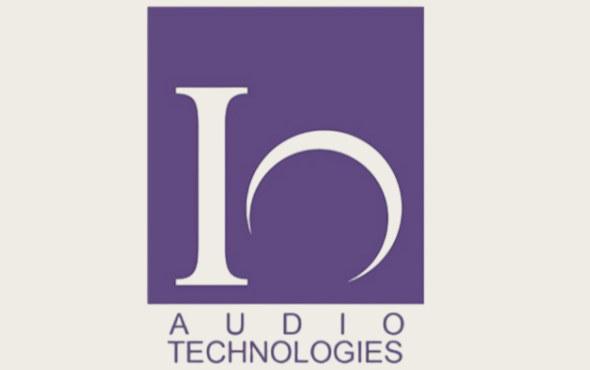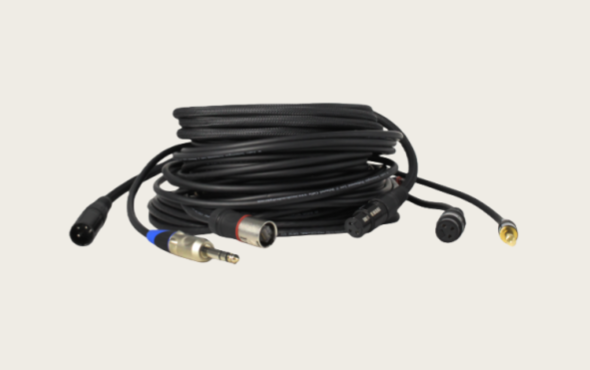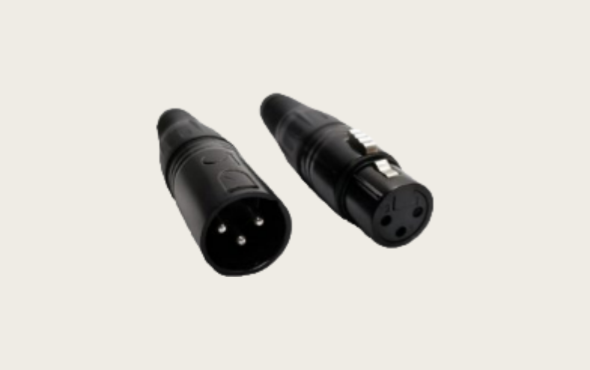In the professional audio interconnect field, brands like Io Audio have always provided high-quality XLR connectors, panel socket connectors, and other connector products, focusing on high-fidelity, reliable connections, and customizable services. This article will take Io Audio as a representative to discuss the issue of "whether domestically produced connectors have the ability to reach IP69 (or IP69K) level within the next 5 years." We will first review the product characteristics of Io Audio, then analyze the meaning of IP69 level, and finally assess the implementation path and challenges of domestically produced connectors.

Io Audio products and the current status of the connector market●Io Audio states that its connectors, cables, and interconnect products have over 40 years of experience, emphasizing "Value Add & Custom Solutions."
Its products include XLR cable connectors, XLR box jacks, 1/4" PHONE jacks, network/audio connectors, etc.
Although its official website does not emphasize the "IP69" environmental protection level capability in its public product information, its products have already possessed higher reliability, customized services, metal structure, and gold-plated contacts in audio/stage applications.
Based on this, the positioning of Io Audio can be considered as a "high reliability, professional interconnection" category. For domestic manufacturers, if the goal is to replace such brands and extend to more stringent environments (such as outdoor, industrial-grade, and cleaning environments), achieving "IP69 level" connectors will be a powerful direction.

The meaning and technical requirements of IP69 (or IP69K) level
IP69 and IP69K are protection ratings for electrical equipment according to the international standard IEC 60529, also known as the Ingress Protection (IP) code. These ratings indicate the degree of protection that electrical equipment provides against the intrusion of solid objects, dust, and water.
1. IP69: This rating signifies a high degree of protection against the intrusion of dust and water. It is typically used for equipment that is exposed to high-pressure, high-temperature, and high-velocity water jets. IP69 is often used in the food and beverage industry, as well as in the pharmaceutical industry, where equipment must be extremely clean and resistant to water damage.
2. IP69K: This rating is an extension of IP69 and provides even higher protection against water. IP69K is designed for equipment that must withstand the most extreme conditions, such as high-pressure, high-temperature, and high-velocity steam jets. It is commonly used in applications where equipment is exposed to harsh cleaning processes, such as in the automotive industry.
Technical requirements for IP69 and IP69K:
1. Water resistance: Equipment with IP69 or IP69K ratings must be able to withstand high-pressure water jets from all directions. For IP69, the water pressure should be at least 12 bar (174 psi) at a temperature of at least 80°C (176°F). For IP69K, the water pressure should be at least 16 bar (232 psi) at a temperature of at least 80°C (176°F).
2. Dust resistance: Equipment with IP69 or IP69K ratings must be completely protected against the intrusion of dust. This means that no dust particles can enter the equipment and cause damage.
3. Temperature resistance: Equipment with IP69 or IP69K ratings must be able to operate within a specific temperature range. For IP69, the operating temperature range is typically -40°C to +85°C (-40°F to +185°F). For IP69K, the operating temperature range is typically -40°C to +100°C (-40°F to +212°F).
4. Cleaning resistance: Equipment with IP69 or IP69K ratings must be able to withstand harsh cleaning processes, such as high-pressure water jets and steam cleaning.
5. Material resistance: The materials used in the construction of equipment with IP69 or IP69K ratings must be resistant to corrosion and other forms of degradation caused by exposure to water and chemicals.
In summary, IP69 and IP69K are high-level protection ratings for electrical equipment, indicating a high degree of resistance to water and dust. These ratings are required for equipment used in harsh environments where cleanliness and water resistance are critical.Before assessing whether "domestic connectors can reach IP69 level," let's first clarify the meaning of IP69:
●"IP" is the Ingress Protection (IP) rating system, where the first digit represents the dust protection level (0-6), and the second digit represents the waterproof/liquid intrusion protection level (0-9, 9K).
●IP69 (or commonly referred to as IP69K) indicates that the product not only needs to be completely dustproof (i.e., grade 6) but also capable of withstanding high-pressure, high-temperature water jet cleaning from different angles and close proximity.
●Test standards such as: the nozzle is washed with high-pressure hot water (e.g., 80 °C, 80-100 bar) from multiple angles to clean the connector housing, while confirming no dust intrusion in a dust environment.
This grade is usually used for heavy vehicles, industrial equipment, food processing equipment, and outdoor cleaning environments, as connectors in these situations need to withstand extreme conditions such as strong jet water, high temperature, dust, and vibration.
Therefore, if the domestic connector aims to reach the IP69 level, it means that it must meet higher requirements in terms of mechanical design, sealing structure, material selection, testing capability, process control, and certification ability.

Three, can domestic connectors reach IP69 in the next 5 years? Assessment perspectiveThe following analysis will be conducted from three aspects: "opportunities", "challenges", and "realization path" to examine whether domestic connectors can achieve IP69 level in the next 5 years.
Opportunity point
●The domestic connector manufacturing industry has made significant progress in mold processing, metal shell, coating treatment, and automated testing in recent years, which lays a foundation for improving protective performance.
The demand for "outdoor" and "industrial" connectors in the market is increasing, including stage equipment, outdoor performances, intelligent transportation, automation equipment, robots, cleaning equipment, etc., which may require high protection level connectors. If domestic manufacturers can seize this demand, the IP69 level will become a competitive advantage.
With cost and supply chain advantages, domestic connectors are expected to replace imported brands in high-end applications if they can achieve high reliability and high protection capabilities.
3.2 Challenge points
●High requirements for sealing, structure, and process to reach IP69: Special design and verification are required for sealing rings (O-rings), locking structures, waterproof shells, shock-resistant designs, and resistance to high-temperature jet water, etc.
●Test capability and certification threshold: To obtain IP69 certification, manufacturers must possess or cooperate with the corresponding test equipment and third-party certification capability. For many small and medium-sized manufacturers, this is still a shortcoming.
●Cost Increase: Connectors with IP69-level structure are more expensive than ordinary connectors, including higher-grade materials, mold precision, testing processes, labor, and testing time. Domestic products pursuing low cost + high protection may face profit pressure.
●Brand and Customer Trust: Although domestically produced products are making progress, in the professional audio/interconnect device market, users are accustomed to trusting imported brands or brands with rich experience. It takes time and case accumulation to persuade customers to adopt "domestic IP69 connectors."
3.3 Implementation Path (Outlook for the Next 5 Years)
Considering these opportunities and challenges, I believe it is possible for domestic connectors to reach the IP69 level within 5 years, but there will be a phased improvement. The suggested roadmap is as follows:
● Phase one (1-2 years): The domestic connectors first achieve IP67/IP68 level, that is, dustproof + waterproof or ordinary water jet. Accumulate experience through mid-to-high-end applications.
● Stage two (3-4 years): Strengthen the sealing and locking structure on the existing foundation, and carry out high-pressure water jet testing, transitioning to IP69. Collaborate with industry customers (such as performance equipment, outdoor sound equipment, traffic equipment) for trial use.
● Stage three (end of 5 years): The mass-produced products pass the certification of the laboratory and are marked with IP69/IP69K. At this time, the domestic connectors have reached the level of substituting imported brands in terms of structural reliability, sealing technology, testing system, and brand recognition.
As of now, brands like Io Audio have not explicitly marked IP69 in public information, but their high reliability positioning provides a learning standard for domestic manufacturers. If domestic manufacturers can grasp structural design, sealing technology, material selection, and testing mechanisms, they will have the opportunity to enter the high protection connector market within five years.

Suggested recommendations for product promotion and procurement partiesWhen selecting or purchasing connectors, if the future operating environment involves high-pressure cleaning, outdoor harsh conditions, stage lighting equipment, traffic equipment, or robot equipment, it is recommended to prioritize "protection grade" as one of the important criteria.
Ask the connector manufacturer whether they have IP67/IP68 and IP69 test reports, whether they have high-pressure jet water testing, seal ring design, and locking structure design.
●If you are a domestic substitute manufacturer/purchaser, consider making "Target for the next 5 years: IP69 structure" a product planning direction, and communicate with customers about "We are moving towards high protection connectors" as a differentiated advantage.
Emphasizing "not only reliable audio/interconnect but also strong environmental tolerance" in promotion will be more persuasive and suitable for more high-end application scenarios.
For whole machine manufacturers, when replacing imported brands with domestic connectors, "high protection level" can also be regarded as one of the subsequent upgrade routes to enhance the stability and reliability of the equipment in outdoor or harsh environments.

Overall, in the past, connectors focused more on mechanical insertion and removal, electrical contact, and signal integrity, but the trend for the future development of connectors is towards "protection level + environmental tolerance". High-reliability connectors represented by Io Audio have positioned themselves as "high-end interconnects". If domestic manufacturers can incorporate the "IP69 level" into their product roadmap within the next five years—from structure, sealing, testing, certification, and brand, to gradually break through—then domestic connectors will have stronger capabilities to replace imported brands in more extensive and harsh environments. For equipment manufacturers, system integrators, and connector manufacturers, proactively planning for high-protection-level connectors will be the key to capturing the future market.
If you are interested in the domestic substitute products for Io Audio brand connectors or have procurement needs, or if you have production or sales channels for these domestic substitute products and wish to engage in in-depth cooperation or communication, please contact via the following contact information:
Manager Zhang (18665383950, WeChat number the same)Contact us, we look forward to working together with more industry partners.




